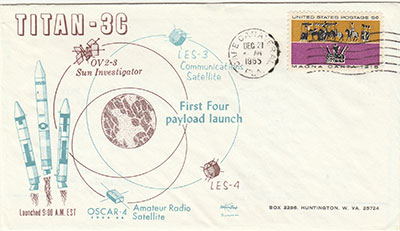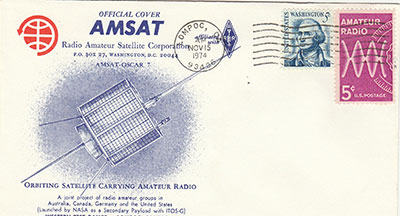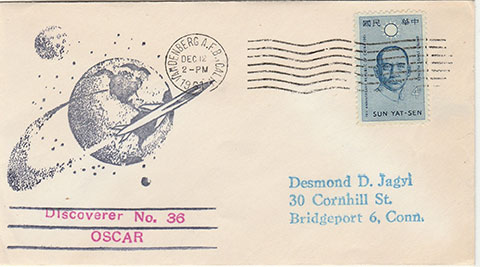Space Cover ##538 Who is OSCAR and Why Give Him a Piggyback?Amateur radio operators or "hams" might know who OSCAR is but the general public might not. OSCAR stands for Orbiting Satellite Carrying Amateur Radio as designated by AMSAT. These were small, privately funded satellites launched into orbit for the purpose of hams around the world to communicate through using both Morse Code or voice. These satellites are quite small and are similar to today's cubesats but were developed decades before cubesat technology became available.
The first cover pictured above is for the launch of Discoverer-36. The Discoverer program was advertised as a space research program but in reality was the civilian cover story for the highly classified Corona program to photograph and spy on the Soviet Union. Launched with the main US Air Force KH-3 satellite was the 22lb OSCAR-1 satellite. This answers the question of why give OSCAR a piggyback. OSCAR-1 was used mainly for ballast during the launch but also became the first satellite built by amateurs, the first private non-government satellite, and the world's first piggyback satellite. OSCAR-1 transmitted the Morse Code signal "Hi" for 22 days and re-entered the atmosphere on January 31, 1962.

As the OSCAR satellites are privately built, AMSAT does not have the budget to purchase launch services on their own. Most, if not all of the OSCAR satellites were launched with other payloads, continuing the piggyback launch method that OSCAR-1 initiated. The second cover pictured shows the first 4-payload launch on a Titan-3C. The booster suffered a partial failure and did not place the satellites in geostationary orbit. OSCAR-4 operated successfully for nearly 3 months.
The final cover (below) is for the launch of OSCAR-7. This was the 2nd of the Phase-II satellites with much greater communications capability. Again launched as a piggyback secondary payload to NASA's ITOS-G, OSCAR-7 operated until a battery failure in 1981. However, it has been heard from off and on as late as 2015 making it the oldest amateur satellite still in use.

As many of my space covers hold a personal meaning, the OSCAR covers are no different. Both my dad and brother are ham radio operators. Dad used OSCAR satellites many times throughout the late 70's and early 80's. He mainly used OSCAR-6, 7 and 8 and one or two of the Russian amateur satellites and was able to accomplish a couple of amazing feats. He accomplished what the American Radio Relay League awards Satellite WAS or Worked All States. This includes communication with another amateur radio operator through a satellite and getting confirmation via a QSL card in each of the 50 states.
Working Hawaii through a low Earth orbiting satellite might not be so tough to do in say Kansas but it as pretty difficult to do from New Jersey. Dad's proudest achievement is probably his award for Satellite DXCC. This is working through a satellite and getting QSL confirmation with 100 countries around the world. Dad was only the fifth person in the world to accomplish this award.
Any other ham radio operators out there?

















